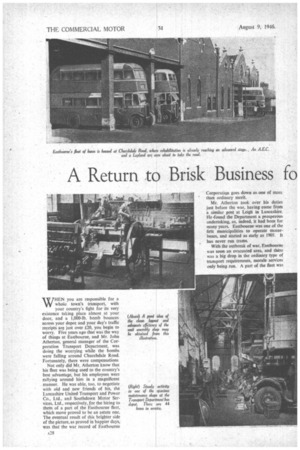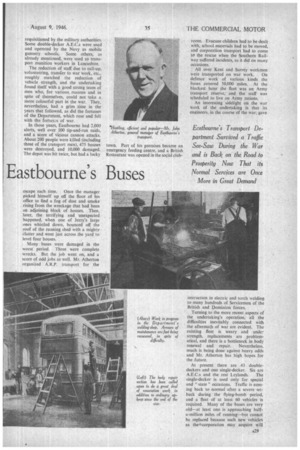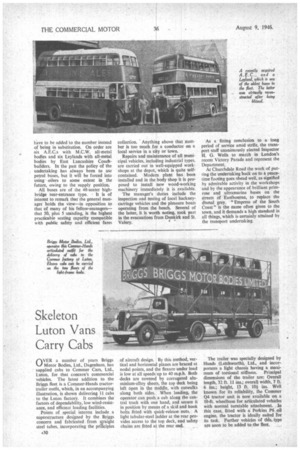A Return to Brisk Business fo
Page 30

Page 31

Page 32

If you've noticed an error in this article please click here to report it so we can fix it.
Eastbourne's Buses WHEN you are responsible for a whole town's transport, with your country's fight for its very existence taking place almost at your door, and a 1,000-lb. bomb bounces across your depot and your day's traffic receipts arc just over £20, you begin to worry. Five years ago that was the way of things at Eastbourne, and Mr. John Atherton, general manager of the Corporation Transport Department, was doing the worrying while the bombs were falling around Churchdale Road. Fortunately, there were compensations
Not only did Mr. Atherton know that his fleet was being used to the country's best advantage, but his employees were rallying around him in a magnificent manner. He was able, too, to negotiate with old and new friends of his, the Lancashire United Transport and Power Co., Ltd., and Southdown Motor Services, Ltd., respectively, for the hiring to them of a part of the Eastbourne fleet, which move proved to he an astute one. The eventual result of this brighter side of the picture, as proved in happier days, was that the war record of Eastbourne Corporatiqn goes down as one of more than ordinary merit
Mr. Atherton took over his duties just before the war, having come from a similar post at Leigh in Lancashire. He (cnmd the Department a prosperous undertaking, as. indeed, it had been for many years. Eastbourne was one a the first municipalities to operate motorbuses, and started as early as 1903. It has never run trams.
With the outbreak of war. Eastbourne was soon an evacuated area, and there was a big drop in the ordinary type of transport requirements, morale services only being run. A part a the fleet was requisitioned by the military authorities. Some double-decker A.E.C.s were used and operated by the Navy as mobile gunnery schools. Some others, as already mentioned, were used to transport munition workers in Lancashire.
The reduction of staff due to call-up, volunteering, transfer to war work, etc., roughly matched the reduction of vehicle strength, and the undertaking found itself with a good strong team of men who, for various, reasons and in spite of themselves, could not lake a more colourful part in the war. They, nevertheless, had a grim time in the years that followed, as did the fortunes of the Department, which rose and fell with (ha fortunes of war.
In those years, Eastbourne had 2,000 alerts, well over 100 tip-and-run raids, and a score of vicious cannon attacks. About 200 people were killed (including three of the transport men), 475 houses were destroyed, and 10,000 damaged. The depot was hit twice, but had a lucky escape each time. Once the manager picked himself up off the floor of his office to find a fog of dust and smoke rising from the wreckage that had been an adjoining block of houses. Then, later, the terrifying and unexpected happened, when one of Jerry's large ones whistled down, bounced off the roof of the running shed with a mighty clatter and went just across the yard to level four houses.
Many buses were damaged in the worst period. Three were complete wrecks. But the job went on, and a score of odd jobs as well. Mr. Atherton organized A.R.P. transport for the room. Evacuee children had to be dealt with, school materials had to be moved, and corporation transport had to come to the rescue when the Southern Railway suffered incidents, as it did on many occasions.
All over Kent and Surrey workmen
were transported on war work. On defence work of various kinds the buses covered 50,000 miles. At the blackest hour the fleet was an Army transport reserve; and the staff was scheduled to live on Army rations.
An interesting sidelight on the war work of the undertaking is that its engineers, in the course of the war, gave instruction in electric and torch welding to many hundreds of Servicemen of the British and Dominion forces.
Turning to the more recent aspects of the undertaking's operation, all the difficulties inevitably connected with the aftermath of war are evident. The existing fleet is weary and under strength, replacements are problematical, and there is a bottleneck in body renewal and repair. Nevertheless, much is being done against heavy odds and Mr. Atherton has high hopes for the future.
At present there are 43 doubledeckers and one single-decker. Six are
A.E.C.s and the rest Leylands. The single-decker is used only for special and " state " occasions. Traffic is coming back to normal after a severe setback during the flying-bomb period, and a fleet of at least 60 vehicles is required. Many of the buses are very old—at least one is approaching halfa-million miles of running—but cannot be replaced because such new vehicles as the*corporation may acquire will
have to be added to the number instead of being in substitution. On order are six A.E.C.s with M.C.W. all-metal bodies and six Leylands with all-metal bodies by East Lancashire Coachbuilders. In the past the policy of the undertaking has always been to use petrol buses, but it will be forced into using oilers to some extent in the future, owing to the supply position.
All buses are of the 48-seater high bridge rear-entrance type. It is of interest to remark that the general manager holds the view—in opposition to that of many of his fellow-managersthat 50, plus 5 standing, is the highest practicable seating capacity compatible with public safety and efficient fares collection. Anything above that number is too much for a conductor on a local service in a city or town.
Repairs and maintenance of all municipal vehicles, including industrial types. are carried out in well-equipped workshops at the depot, which is quite selfcontained. Modern plant has been installed and in the body shop it is proposed to install new wood-working machinery immediately it is available.
The manager's duties include the inspection and testing of local hackneycarriage vehicles and the pleasure boats operating from the beach. Several of the latter, it is worth noting, took part in the evacuations from Dunkirk and St. Valery. As a fitting conclusion to a long period of service amid strife, the transport staff unanimously elected Inspector H. G. Wells to march in London's recent Victory Parade and represent the Department.
At Churchdale Road the work of putling the undertaking hack on to a peacetime footing goes ahead well, as signified by admirable activity in the workshops and by the appearance of brilliant primrose and ultramarine buses on the streets of Eastbourne, to replace the dismal grey. "Empress of the South Coast" is the name often given to the town, and it demands a high standard in all things, which is certainly attained by the transport undertaking.




































































